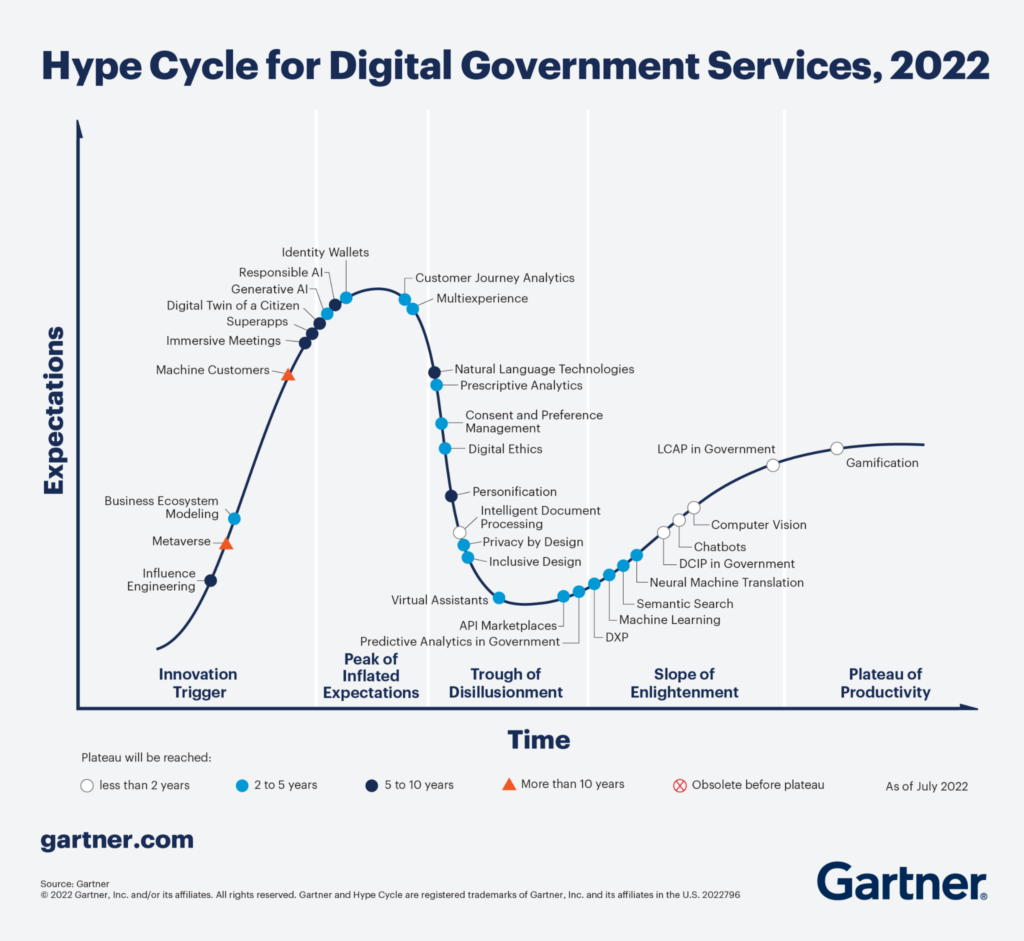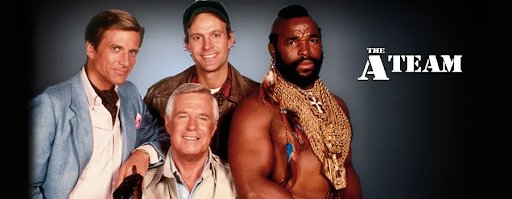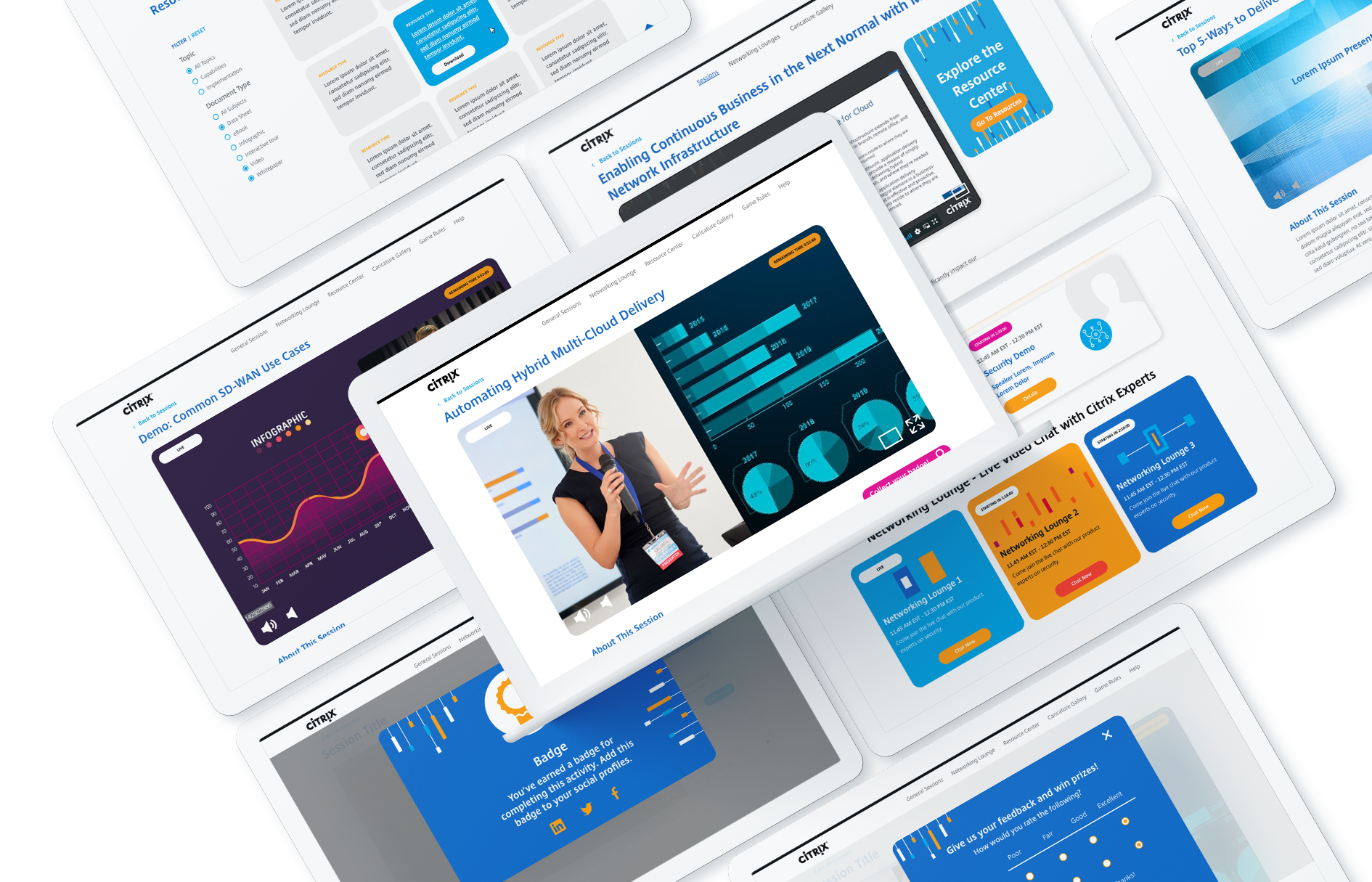Digital transformation creates challenges and opportunities for B2G marketing leaders seeking to sell to government agencies. The appetite for digitization of citizen services accelerated during the pandemic as agencies recognized a more intense need to transform communications and engage with citizens. At the same time, the DoD moved forward with a digital-forward strategy to guide the industry on how to best deliver transformative technologies.
B2G brands competitively positioning themselves to pursue and capture digital transformation-driven contract opportunities benefit from a smart, holistic public relations program aligned with the pace at which agencies are evaluating, adopting, and deploying new technologies.
So much of Bluetext’s PR and marketing work with government contractors and IT providers involves a keen understanding of how government buyers evaluate, procure and deploy technologies and services – and the messages that resonate most with them. For B2G marketers creating PR programs that tap into public sector digital transformation, there are a few key considerations:
Agencies Don’t Transform Overnight
Less than one in ten (7%) government leader respondents in an EY 2022 report said they believe their organization has achieved its digital transformation goals. This doesn’t mean that digital transformation isn’t moving forward but serves as a gut check that B2G brands must stay attuned to the pace of change.
The tricky balance for B2G CMOs is to effectively communicate how their products, technologies, and services can future-proof agencies while acknowledging that legacy technology investments cannot be unwound overnight. In other words, media coverage and thought leadership cannot ignore where agencies are today.
Similarly, there are nuances to digital transformation messaging, for example when it comes to workforce automation. PR may be required to address the fact that, among government workforces, transformation can create uncertainty. Artificial Intelligence and automation can equate to fears of employees being replaced. If B2G brands leave it up to the agency customer to overcome workforce resistance to new technologies, adoption can be slowed and contract opportunities will dwindle.
Match Thought Leadership To Right Hype Cycle
There are perils to spinning wheels on Gartner Hype Cycle™ “Innovation Trigger” technologies that may be garnering media coverage but are years away from commercial viability. The “Innovation Trigger” hype cycle phase refers to when “A potential technology breakthrough kicks things off. Early proof-of-concept stories and media interest trigger significant publicity. Often no usable products exist and commercial viability is unproven.”
In the 2022 Gartner Digital Government Services Hype Cycle, the research firm identifies technologies such as Metaverse, immersive meetings, and influence engineering and machine customers that are years if not decades away from reaching a plateau.

In the same way that CIOs need to keep their eyes on potentially transformative technologies and practices that are years from widespread adoption – and start developing positions on these trends – marketers must think about how best to associate their brands with these emerging technologies. Thought leadership programs are a good place to start.
We work with B2G brands that face diverse challenges on the sales side. For some, they may be an established, credible brand seeking to sell a product or technology their brand isn’t traditionally associated with. This could be a result of mergers and acquisitions that have unlocked new product portfolios and capabilities. In other cases, behemoth brands are being challenged by nimble, upstarts perceived to have more cutting-edge solutions. Hundreds of challenger brands have turned to Bluetext for PR services to help provide air cover for the sales team – so that they aren’t spending half the meeting establishing credibility and can just sell based on merits.
Finally, disruptor technologies can create sufficient confusion to paralyze the buying process. Thought leadership can educate target markets to prevent this from occurring. Case in point: ChatGPT, which is spinning the heads of marketers and communications professionals across all industries. If you provide automation technologies to the public sector, agency decision-makers may wonder if a costly solution will be rendered obsolete by ChatGPT in 12-18 months and decide to wait it out. More likely, ChatGPT can be used to augment a solution, but buyers will never know that without effective earned and paid content campaigns.
Thought leadership programs are an effective way for B2G marketers to:
- Start associating your brand with trends and technologies that you will be offering in the near future without creating headaches for the sales team by sending traffic to a source with no product
- Educate the market on pain points that your solution will address, so that when you do launch the value proposition has been established
- Build up a Subject Matter Expert (SME) program with experts who can become sources on these technologies for journalists or generate interest from conference organizers
Data-Driven PR Can Make Or Break The Transformation Case
B2G brands often sit on access to PR-valuable data that is untapped for various reasons. Are state and local government leaders tapping AI to deliver citizen services? Will federal healthcare leaders increase their spending on data analytics in the upcoming fiscal year? There are external entities that track some of this data, and there is always the option to drop $25,000 on a research firm to create a survey vehicle. But most firms have built valuable mechanisms to reach customers and prospects via email and other channels, and there are seamless, non-intrusive approaches to acquiring market data that can be used to anchor PR initiatives (media pitches, bylines, social media posts, etc.).
The value of the data is to gain a stronger foothold on where your customers and prospects are as it relates to digital transformation. Leveraging that data for media pitches, byline articles and social media strengthens the business case that there is a need and appetite for your technologies.
Get Creative Telling Customer Stories
From a PR and marketing perspective, it isn’t the word of the B2G brand that will have the greatest impact on an agency prospect – it is the voice of the customer. Because agencies moving forward with digital transformation want to see that what they want to do has been done before. That digital transformation is possible, that ROI is quantifiable and that investments are justifiable.
The problem? It can be extremely difficult to secure approval to publicize government customer stories through press releases, media coverage, website case stories or via social media. This is a common frustration our clients and prospects often mention right off the bat. Traditional methods of securing agency approval rarely work, which is why Bluetext deploys creative approaches to tell a customer story through award programs, events and other mechanisms.
If you would like to learn more about how to effectively create a B2G PR program that taps into public sector digital transformation, reach out to Bluetext at https://bluetext.com/contact-us/.
Executive visibility is a critical component of any effective communication strategy. Through well-thought-out and strategically developed programs, organizations can increase employee engagement and retention, establish trust and credibility, and ultimately foster growth and success by making leaders visible to stakeholders, customers, and employees.
To optimize the ROI of your executive visibility program, it is necessary to do more than simply make executives more visible. Organizations need to approach these efforts with a focus on best practices and concentrate on key strategies in order to fully utilize this potent instrument.
We’ll review some of the most effective methods and approaches to help you maximize your executive visibility program’s return on investment.
Specify your goals
Defining your goals is the first stage in any effective communication strategy. What do you want more executive exposure to accomplish? Is it to increase credibility and faith among stakeholders? Increase retention and interest among employees? For prosperity and growth? Developing a robust executive visibility strategy will help create a clear road map to success by defining your goals.
Choose Your Primary Audience
The next stage is to determine your key audiences after you have defined your objectives. What customers, partners, clients, and staff do you want to reach with your executive visibility initiatives? You can customize your messaging and communication channels to reach and engage your key audiences by having a solid knowledge of who they are and where you can engage them.
Leverage Multiple Channels
In order to increase executive visibility, it’s crucial to use a variety of contact channels. This can include conventional media like email and newsletters, as well as contemporary ones like social media, webinars, and live events. Working with your communications team, you can ensure that your message is engaging and compelling to your target audiences by using a range of mediums to reach them where they are.
Focus on Authenticity and Openness
Authenticity and transparency are two essential components of effective executive visibility programs. Your executives can establish confidence and credibility with your key audiences by communicating in a genuine and honest manner. Sharing one’s own experiences, triumphs and failures, and even vulnerabilities can create stronger connections and boost stakeholder involvement and loyalty – all by being open and sincere.
Involve Your Team
Finally, it’s important to involve employees in your efforts to increase executive visibility. You can cultivate a culture of openness and transparency by encouraging team members to share their own experiences and viewpoints. This helps expand your sphere of influence, and as additional team members join in serving as brand ambassadors for your company, this can also aid in establishing credibility and trust with outside stakeholders.
Reap the Benefits with Bluetext
Increasing the prominence of executives within your company generates a competitive advantage and positions your business as innovative and customer-focused. It helps improve the executive’s communications and leadership skills, both directly and indirectly, while developing trust and rapport with customers and business partners and can be a mechanism for thinking through industry problems and solutions and testing new ideas.
At Bluetext, we see you and hear what you have to say, and we help make sure that your stakeholders do as well, whether they are your customers, employees, prospects, or investors. Every leader is unique, as are their voices, platforms, and messages. Because of this, we tailor our executive visibility strategy to be specific to you and your brand to cultivate and highlight the inner strengths of your executive(s) and company in ways that will provide the greatest opportunity to achieve a significant return on investment for your executive visibility program.
Contact us to learn more about our public relations & earned media services.
Press releases have long been the quintessential staple of a Public Relations and Communications business strategy. They announce company wins, news, executive moves, and critical shareholder updates.
While they’ve always been necessary, the frequency with which companies distribute press releases varies depending on company preferences and what critical stakeholders deem “newsworthy”.
Can a More Robust Press Release Strategy Drive Website Traffic?
However, this is an antiquated approach that needs to be re-examined. With a more robust press strategy, businesses can continually target the right distribution list, improve search engine optimization (SEO) and leverage these content pieces for social channels, all of which lead to increased traffic on their website. As a top public relations agency, Bluetext PR specialists have broken down the key elements of press release strategies that drive results.
The Right Distribution List
When pushing press releases out on your preferred wire service, identifying which distribution list to publish on is critical. It enables businesses to get their news published in outlets that have perhaps been difficult to break into, ones that are prominent in the organization’s industry, and news sites that reach the businesses’ targeted demographics.
As newsrooms have gotten smaller, major outlets have also increasingly relied on releases that are published on wire services to continue churning out content.
With the right distribution list, the organization putting out the news reaches existing and new audiences. If executed properly, these releases will have links that readers can click on and drive them back to the company’s website.
Improved SEO
Those hyperlinks also play an important role in improving a company’s SEO position. Not only do they prompt readers to learn more about the company’s products and services, but they naturally increase the page rank. The higher the page rank, the higher the site will be ranked by search engines. The higher the site is ranked, the more frequently it will appear in audiences’ searches.
Leveraging Content on Social Channels
Press releases are also important content to leverage for a company’s social channels. There are three main ways to maximize the visibility of these announcements:
- Share on the company’s channels;
- Have employees share the news from the business’ profile with their own network;
- Targeted ad spending to get the posts in front of specific audiences that are deemed crucial customers.
While creating a consistent cadence of press releases should be the goal, businesses need to be careful not to flood the market with a constant barrage of saturated news updates. Instead, map out a strategy that aligns with business initiatives throughout the year. Once that plan has been finalized, organizations can then identify the distribution lists, backlinks that will boost SEO, and corresponding social strategies that will drive the most amount of traffic back to their website.
Ready to power up your PR strategy? Contact Bluetext today to learn more about our public relations expertise & services.
Al Davis, the former coach and owner of the Oakland Raiders, famously coined the phrase “Just win, Baby!”. And while that’s the goal for any PR agency building out an award nomination for clients, it’s easier said than done. How do agencies make their nomination stand out from the thousands of others that the judges receive? What do clients gain from winning these honors? For such a common staple in PR campaigns, award nominations are often not leveraged for maximum impact.
How to Build a Winning Nomination
Bluetext develops and executes award programs for clients across a broad range of industries and verticals. We hold considerable expertise with B2B Tech and B2G Tech Award Programs, and based on our experience, here are some keys to success when it comes to winning award submissions:
First, avoid cluttered technology jargon and be clear in your nominations.
Award nominations that struggle to present a compelling case are often guilty of being too product-oriented. Assume the judges do not know anything about your solution. It’s crucial to articulate the benefits in as clear of a manner as possible rather than just stuffing entry sections with generic content to hit word count targets.
Second, before submitting your final nomination, ask yourself – does this nomination address what the judges are looking for in a submission?
It’s always important to build a nomination that fits what the judges are looking for. Do you homework on the criteria and past winners. The website of the organization hosting the awards often has a list of criteria on what to answer when nominating clients’ solutions. In fact, some of them even hold webinars on what defines a winning submission. Adhering to those guidelines offers the best chance of winning.
Third, when drafting award nominations, it’s important to tell a story about how the solution is addressing a significant industry problem.
Build a case for the product you are nominating by answering the following questions – What’s the industry problem? What separates a client’s technology from industry competitors? Why does this particular piece of technology drive superior results? Winning nominations offer such an intriguing story about their clients’ products that the judges can’t help but recognize the importance of this solution.
Finally, always be honest with clients.
Just because a client wants to move forward with an award doesn’t mean it is a smart use of time and financial investment. If you have concerns, make your case or push to strengthen the nomination. Review past year’s award winners to demonstrate what it really takes to bring home the hardware.

Benefits of Winning Awards
Bluetext also believes there are four key benefits of winning these awards:
1. Enhances Brand Reputation
Winning awards provides positive momentum for a company’s solutions by offering third-party validation of a client’s technology or executive team leadership. Wins serve as testaments to the hard work the company has been putting into its solution. These accreditations boost both internal and external stakeholders’ confidence in the product and the company’s direction.
2. SEO Boost
Award wins are easy opportunities to leverage in press releases and social media. Often, the organization behind the awards will also celebrate the winners with press releases of their own. Wins are therefore easy ways to bring your company to the top of search engines’ results page.
3. Unlocks Important Networking Opportunities
Typically, awards come with a presentation or ceremony that presents opportunities to mingle with businesses and executives in the same industry. Furthermore, the increased brand awareness that comes with winning awards may open the doors to new business opportunities and potential partnerships.
4. Air Cover For Sales Teams
For many tech companies, especially those competing with more recognized names – sales teams often spend a chunk of their new business meetings establishing brand credibility. Showcasing highly regarded award wins can assist in overcoming the credibility hump.

The Last Piece of the Puzzle
Finally, before drafting the award, be sure it aligns with the client’s overall PR goals and strategy. Oftentimes these awards have a cost associated with them. With that in mind, it is important to align with clients on what nominations make the most sense for their overall PR strategy to get the most out of this investment.
Learn more about Bluetext’s success in submitting award nominations and contact us if you’re interested in partnering with us to get your award nominations on track.
Finding Success in Public Sector PR
According to Fortune, Walmart is considered the largest company globally, with an annual budget of approximately $524 billion dollars. However, one entity dwarfs Walmart with a massive $1.5 trillion dollar budget – The Federal Government of the United States. Although many analysts predict a slump in procurement spending in 2022, the United States federal government is still the most lucrative and prized customer globally.
Finding success in communicating with government customers is an area many companies fall short of due to a fundamental misunderstanding of the golden rule of the public sector: Communicating to the government is uniquely different from any other audience, whether it be businesses or consumers.
To navigate these unique waters, you need an experienced team that understands the government agency and worker from top to bottom and who works and breathes the ins and outs of the ever-changing and complex world of communicating with the public sector. Also, know that a true public sector communications professional is a rare breed. While some PR professionals have worked for a public sector client, there are painfully few that specialize in this area, and they are becoming harder and harder to find.
Give it to the pros. You go to a doctor when you are sick. You seek a lawyer when needing legal advice. Even the military has special forces to handle the most difficult tasks. It is imperative to know when to seek the skills and guidance you need for a specialized task. The communications and networking landscape that is more complicated than ever, so don’t attempt to navigate it without qualified public relations guidance.
If you have a public sector division, you need a specialized team to support your engagement and communications efforts. It’s a lot like the intro to the 80’s TV show the A-Team.

If you have a problem, and no one else can help, and if you can find them, maybe you need to hire. . .
the Public Sector PR team.
Without having to get into any arguments on where Mr. T fits into the grand scheme of my symbolism, the important takeaway is simply this: a public sector PR team is a lean, highly-specialized group of professionals that will provide support and guidance for your organization to maximize success in the government space. Full Stop.
Unique Needs of the Public Sector
Government agencies and the people that work within have uniquely different needs and offer challenges not seen in private sector businesses. They respond to their own language and terminologies – and traditional marketing buzzwords fall flat in the government sector. In order to engage and communicate effectively, your public sector PR program needs to speak to the distinct demands and needs of both the government official and their respective agencies’ core mission.
Simply inserting words like ‘federal’ and ‘government’ into your existing enterprise messaging is not going to cut it with government audiences. Government employees have their own language, with each agency having a distinct dialect with mandates, certification requirements, and other factors that dictate how they shape their needs as well as find vendors. Federal, state, local, and education entities each have needs and challenges you need to hand-tailor your approach, messaging, and engagement to truly resonate with these audiences.
By having a B2G Public Relations team, you gain the proficiency and experience required to establish your organization, brand, people, and offerings to the public sector customer in a manner that provides long-term stability and success.
State, Local, and Education (SLED) PR
Much like federally public sector PR – state, local, and education comms require a specialized approach and methodology in order to educate, help drive leads, and raise awareness for your brand and services – often in multiple target regions. This is where your public sector PR team will also show extreme value in that SLED communication programs can be executed from any location, giving your organization both awareness and presence in multiple target areas without the need to have permanent ‘boots on the ground.’
Why is this important now? Government contracting dollars and opportunities for state, local, and education (SLED) budgets have made a comeback in 2022, with states showing the largest annual spending increase in more than a decade and many reporting tremendous tax revenue growth from 2021. This, coupled with federal aid from the American Rescue Plan Act and the infrastructure bill, point to substantial opportunities with SLED entities – and the right PR and marketing strategy can help you take full advantage of these opportunities.

A public sector SLED team is specially equipped to handle multiple regions with different cultural, governmental, and social norms to help you project an expansive market footprint for your brand and expertise in mission-critical areas. Whether it’s in Houston, Texas, or Fairbanks, Alaska, a strategic SLED PR campaign will help establish your presence where you need it.
Public Sector PR Expertise
Public sector teams, their missions, and definitions of success come in all shapes and sizes, many times wholly different from the rest of the business – and your communications program and PR team need to as well.
I can’t tell you how many times I’ve heard, ‘I can just use my corporate communications team to handle public sector comms.’ The response to this is a simple question – ‘Are you using your corporate sales team to sell into the public sector?’ Of course not; you need your sales team to know your customer base and the specifics of the marketplace – so you have a team that specializes in the public sector customer. Your organization is making a strategic investment to go after government customers, and that investment should include communications that specializes (just as much as your sales team) in that customer space. While your in-house comms team or corporate agency might be able to help get you started, these efforts will only be table stakes if you don’t have a team that truly understands the federal, state, local, and education sectors.
There are countless unique differences between the public sector and business/consumer corporate communications. Understanding sales cycles, trends that will gain traction, how social media works in the government space, and how to most effectively engage the people who are going to help make a difference in your public sector strategy are just some of the key differences and capabilities a public sector PR team will bring to your team to help drive success.
Measuring Success for Public Sector PR
Historically, measuring PR success has always presented challenges, and traditional means of measurement are not conducive to adequately measuring or portraying success in the public sector. Most companies rely on measuring PR efforts directly back to sales, which in the public sector is a tough row to hoe. Our public sector teams are adept at benchmarking and measuring the metrics that count the most in the public sector.
They have the ability to measure web traffic, inbound leads from content and social media, the share of voice, and qualitative comments from customers and partners – data points your team can rely on to justify and optimize your public sector engagement and confidently measure your public sector PR success.
Find Your Public Sector PR Team
You are now asking yourself – where can I find highly specialized public sector communications professionals to support my needs? Regardless of the size of your company or government division, Bluetext can help you establish, engage and scale your communications to the public sector and get the most out of your communication efforts! Contact Bluetext to help your organization drive B2G brand awareness and lead generation through public relations.
How can you bring in lucrative contracts for your business? B2B social media marketing can be an underutilized, yet incredibly useful channel, given that 62% of CEOs are present on at least one social platform. B2B social media marketing is the use of social channels to market products and services to business clients. All social channels can be used for B2B marketing, but the strategy for each will differ. It’s essential to know the strengths and demographics of various social platforms to effectively reach the targeted decision-makers. Let’s look at some of the top social media channels used for B2B marketing.
3 Social Media Channels Great for B2B Marketing
LinkedIn
LinkedIn is far more than a recruitment platform; it is a great tool to attract talent, but also can go to great lengths to promote your business. More than 30 million companies use LinkedIn, with the most common age group on the site being middle-aged working professionals (36- to 55-year-olds). Serving as the most popular platform for corporate CEOs, LinkedIn can get your business in front of CXOs and other decision-makers to initiate those B2-B relationships. LinkedIn organic and paid media options are viable opportunities positively showcase your company’s achievements and drive traffic to your website. Your organization can demonstrate thought leadership as an industry leader through blog and news posts on trending topics. Not only can you update followers on company progress, but you can also present the employees who make up your organization when there is strategic value in doing so. This conveys company culture, which is a great indication of whether you might be the right potential business partner. LinkedIn also provides plenty of data to better optimize your social campaign and ensure you’re reaching the right decision-makers.

Twitter
Twitter also can be an effective platform for connecting with customers and developing influence. Through short messages, Twitter can be used to portray your brand’s voice. With Twitter, your business can quickly get out a message to an audience and engage with users in real-time. Twitter has 166 million monetizable daily active users, which are logged accounts that are able to show ads. Unlike LinkedIn, Twitter is predominantly used by millennials, meaning it is great for targeting entrepreneurs and younger professionals who are involved in start-ups.

YouTube
With 1.7 billion unique monthly visitors, YouTube is one of the best social media platforms for driving traffic back to your company’s website. Video, as a medium, is a great way to tell your brand’s story and mission. With YouTube, your business can create educational content to display your business’s unique value proposition. People searching for advice and how-to-videos will land on your page, increasing brand awareness and subject matter expertise. Ensure your video is optimized for google search results by placing relevant keywords in the title.

Even for organizations intimately familiar with social channels, there is a science to building B2B social media marketing programs with the optimal mix of channels, content, and timing. Contact Bluetext to help your organization drive B2B marketing results on LinkedIn, Twitter, YouTube, and other social media channels.
The recent Labor Day continued to shine a spotlight on an ongoing problem brought on by COVID-19: The Great Job Exodus of 2021. According to Microsoft’s 2021 Work Trend Index, 40% of the global workforce is considering leaving their employer this year. While many companies adopted more flexible work policies to adapt to the pandemic — with some being here to stay permanently — employees are continuing to experience burnout and businesses are seeing employees flee by the dozens.

Social media platforms such as LinkedIn have exposed a high percentage of PR and marketing professionals leaving their positions no matter the industry or tenure. Businesses large and small are struggling to fill key marcomms positions — specifically those in the mid and senior roles. And who can blame them when they’ve been working for 5 years or more, exhaustedly grinding away with a pandemic raging?
Finding and retaining top in-house talent can negatively impact the ability of marcomms teams to execute. The absence of senior leaders can make it difficult to provide the C-Suite with the strategy and ideas essential to growing the business. Additionally, if you can’t fully staff the team with junior and mid-level professionals, it can bog down more experienced marcoms professionals in tactical, rather than strategic, work.
The current conditions make a strong argument to fill the gap with a tech PR agency, like Bluetext. Leaning on an agency partner for additional services and support can alleviate some of that workload and bring fresh ideas and perspectives to your business. However, picking an agency is no easy task. Businesses need to find trusted advisors and agencies that will be an extension of the company; trustworthy firms that understand your business, products, and values. So, how do you pick the right partner to fill these gaps? Let’s dive in!
Benefits of an Agency Partner vs. In-House Staff
While both options have their benefits, deciding on an agency or in-house staff really depends on what your business is looking for, and it can depend on a variety of factors. While an in-house employee will, over time, know the ins and outs of your brand, it is rare to find an in-house marketer who is adept at all aspects of digital marketing. And if you do find someone who knows all aspects of digital marketing, it could be an overwhelming experience for them and may impact employee retention.
With an agency, you gain the benefit of a team of individuals with complementary skills who already work well together. An agency can also bring a fresh perspective, based on work with others in your industry, and even competitors. In-house marcomm professionals are at times so close to the brand it can lead to overly subjective decisions.
As for media relations, a public relations agency will have years and years of experience in multiple industries. Their media relations roots are continuously growing as they’re passed from client team to client team. Agencies have a plethora of relationships with media that are nurtured continuously from client’s both past and present. In general, agencies have a better understanding of media, industry trends, and the ever-changing media landscape and can easily adapt a strategy to meet the needs of their clients.

What to Ask Yourself when Finding an Agency
1. What are my goals?
This is a no-brainer! What are your marketing goals? The answer will determine which agency is right for you, what resources an agency should have, and more. Does this agency have enough experience and resources to help you achieve core objectives, does it have a presence in your target market or will you be able to build relationships with media through this agency? All of these questions are important to ask when it comes to choosing the correct agency partner.
2. Does my staff have the required resources and skills needed to achieve said goals?
By understanding which marketing tactics your business needs and the resources and skill level needed to do it, you’ll be able to find the right agency for your business. If you’re looking for more comprehensive marketing services none of your in-house roles can accomplish, be sure to pick an agency that has a diverse skill set to cover your bases. As a fully integrated marketing agency, Bluetext has a variety of services we offer to our clients that include messaging, branding, website design and development, go-to-market campaign strategy, public relations, social media, and so much more.
3. What value will I get for the cost?
When evaluating an agency, the math needs to be done to compute the true cost of the output. With an agency, you get the support of an entire team rather than just one person, therefore, getting more for less.
4. What is my budget?
By determining your budget, you can decide how much you can afford to invest in marketing which will dictate how much work your agency will take on. Sometimes what you can afford is too little to drive real results with one agency but can work for another.
Once you’ve asked yourself what your goals, budget, staffing needs, and skillset needs are, be sure to contact Bluetext to learn how our B2B tech PR team can help you fill any in-house skills gaps you are facing.
Given the speed at which news is consumed today, timing is everything. Latching onto a rapidly developing news cycle is a great way to gain visibility for your brand, establish thought leadership on a topic and build relationships with reporters. Rapid response, or newsjacking, opportunities are when brands capitalize on breaking news to provide relevant commentary on the story while drawing attention to their own content.

As brand storytellers, we’re scanning the news daily for what’s happening in the industry, what brands are standing out, how our clients are showing up and more. Thus, implementing a rapid response strategy during your daily news scans is easy, time-efficient and can be very fruitful. However, there are a few things to be wary of, including sensitivities around the news, reaction time and offering valuable insights.
Read the Room
Not every breaking news story needs commentary. Consider the sensitivities around the developing story, read the room and evaluate if a comms strategy is necessary around this cycle. If yes, then designate who your spokesperson will be and develop your commentary.
Amid tragedy at a global scale, like social unrest, natural disasters or pandemic, it is best advised to redirect external communications to focus on internal messaging and making sure employees feel supported. Exploiting tragedy and proactively telling a reporter how a company’s software product might have altered a tragic situation can be perceived as insensitive and will put your brand in a negative light.
A prime newsjacking market is cybersecurity. There are countless hacks that offer opportunities for cybersecurity firms to comment on topics like how the hack occurred, how that kind of hack or bad actor will evolve throughout the year and beyond, background on the hack or bad actor, what cybersecurity protocols can be implemented to prevent the hack from occurring again and more. But the noisier the market (and there are thousands of cybersecurity vendors with something to say), the more you will have to carve out a defined lane and message that reporters will find of value.
Timing Is Crucial
News comes and goes fast. Rapid response opportunities work best when you’re the hare, not the tortoise. In your daily scans, once you see a trending piece or developing piece and think that news cycle will pick up, get ahead — reach out to your spokesperson, pick their brain about how the story will develop, compile their thoughts into a pitch and ship it off to relevant reporters. From there, wait for the story to develop and see if the reporter has any other questions.

Yes, and ?
While timing is crucial in rapid response opportunities, it isn’t everything. Messaging is just as important. It does help to be the first to comment, but other brands won’t be far behind, and if your messaging does not add value to the conversation, it will not be included. On top of that, given the opportunity is industry-wide, keep the commentary broadly applicable but nuanced enough to stand out. This is not the time to gush about your company and the latest products.
There is a time and place for everything. While we as communicators want to jump on as many opportunities as they come, we need to be cautious about the ever-changing news landscape, the sensitivities of the world and the reputational risk that comes with it.
To learn more about how Bluetext can improve your newsjacking processes and timing, contact us today.
What’s the biggest obstacle to securing national media coverage? Companies often struggle to develop a message, pitch, and story that will resonate with Tier 1 journalists. If done right, exposing your brand to a large audience – assuming it is the right audience – can result in stronger brand recognition as well as new business deals. There are a few things to keep in mind as you strive to place a national media opportunity.
Lean into News Attention
The ability to adapt your message and pitch to current stories in the current news cycle unlocks a wider range of opportunities to get in front of a reporter who will cover a certain topic. The pandemic is an extreme, yet instructive example of how companies seeking media coverage had to recognize that COVID-19 was going to dominate the national conversation. This was a challenge, but also an opportunity if your company has legitimate insights and contributions for businesses and consumers.

Craft a Timely Pitch
After determining a topic appropriate to engage with, attention is turned to crafting the message of a pitch. A timely hook and a captivating subject line are two pieces that should be used to grab the attention of a reporter. The body of the pitch should include relevant data and information that would be useful to an article and the conclusion should outline what is being offered to the reporter, such as an interview with a subject matter expert or CXO.
Locate Specific Beat Reporters
Another key aspect of upleveling messaging to gain national media attention is finding specific beat reporters. Aggregating a list of national media reporters from a large range of outlets is essential to find a reporter who will cover a story. Pitching to a wide variety of outlets allows for a higher chance of securing national media coverage. Once the outlets to pitch have been determined, searching for reporters who have very specific beats relating to what you want to be covered is crucial for getting a reporter’s attention.

Be Persistent
Follow-up with reporters that have been pitched in the days after the pitch went out. Sending follow-up pitches to reporters the day after can bump the original email to the top of the reporter’s inbox and remind them of the information shared the previous day. Reporters often will not respond to a pitch if uninterested, but a follow-up email ensures the pitch wasn’t lost in the reporter’s inbox. Strike the right balance; be proactive but don’t beat a dead horse.

National media coverage is important for both brand recognition and business lead generation. Due to recognition of the impact Tier 1 coverage can have, it is always hard to secure coverage in national outlets. Tactics such as leaning into news attention, creating a timely pitch, locating beat reporters, and being persistent will help in securing businesses’ worthwhile press coverage.
To learn more about how Bluetext can help you uplevel your message, contact us today.
We’re now more than a year into the COVID-19 pandemic and admit it: you miss in-person conferences and events. At least a little. While segments of the country are inching back toward some sense of normalcy, it will be a while before thousands of people are gathered in convention centers and hotel conference centers again.
This continues to pose a challenge for traditionally face-to-face organizations that need to reach business, government, and consumer technology decision-makers. Additionally, it’s why many have been evaluating and participating in virtual technology conferences and events, or even shifting their own user conferences and events from in-person to virtual.
As your organization maps out its 2021 in-person, hybrid, and virtual event strategy, there are several considerations when it comes to investing time, money, and resources.

Is This Their First Rodeo?
Technology providers must determine if the event organizer has hosted virtual events in the past. If they are familiar with the virtual event landscape, it is important to determine what attendance and sponsorship looked like at the previous event and if the speaker lineup has been credible and on target. Determining past event involvement can also help speakers form expectations about participation levels. An experienced virtual event host suggests a deeper attendee pool and gives companies a glimpse at the event at hand by looking at past hosted events.
Pay to Play?
It is important for organizations to evaluate investment in sponsored speaking opportunities or sponsorships overall. Speaking engagements provide companies with a hard-to-come-by platform depending on attendance. Speaking slots with no fee associated can be competitive when you’re submitting with a pool of people to a program with strict standards. Sponsored sessions, on the other hand, are easier to get if you’re willing to pay for it, and give speakers more leeway on what they cover. Because of this, organizations should consider how the event host will drive attendance, especially now that travel doesn’t pose an issue, and how the conference content will be made available to optimize virtual viewership.
Try Not ‘Playing to Play’
When looking for opportunities, there are a few key things to consider before nominating a subject matter expert for speaking roles. Various event organizers offer calls for speakers when looking for guests to participate in panels at conferences. The submission form may offer a broad nomination for a general conference or may offer categories in which specific topics will be discussed. Categories narrow down the specificities of the topic the thought leader will be speaking about. It allows experts to delve deeper into the topic at hand and, in turn, highlights the speaker’s expertise. Finding the right speaking role is important, as is including the right members of the press to listen to a speaking engagement for potential coverage opportunities. Inviting reporters from trade publications specific to an industry, as well as national reporters who cover specific topics are valuable assets to optimize additional press opportunities and increase the overall value of the session.
Host Your Own Virtual Event
While industry events are all reeling from the switch from in-person to virtual, this may be the time to consider hosting your own virtual event – if you are not doing so already. There are more avenues now than ever before to bring customers, partners, prospects, and thought leaders together virtually. Even before the global pandemic, some potential event prospects were limited by the event’s location. With digital events, that is no longer an issue. All an attendee needs these days is a viable internet connection. The importance of convening has not gone away, we just had to change the way we approach it.

Bluetext Virtual Events are built on the idea that bringing the right people, information, and ideas together is what events are all about. Our platform was designed to feel as close to a real event as possible, rather than just another webinar, video conference, or live stream.
While some may see virtual events as a Plan B to in-person events, virtual events have brought new opportunities to a wider, global audience. Whether you are looking for the right PR agency partner to navigate the virtual and in-person event landscape or leverage our platform to host your own virtual event, Bluetext can help. If you want to learn more contact us today.